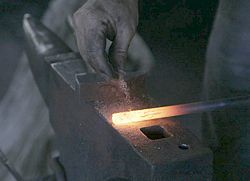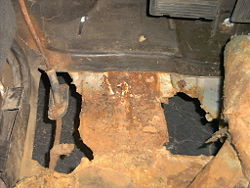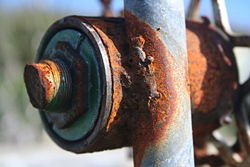Rust
- For other uses, see Rust (disambiguation).
| Iron alloy phases |
|---|
|
Austenite (γ-iron; hard) |
| Types of steel |
|
Carbon steel (≤2.1% carbon; low alloy) |
| Other iron-based materials |
|
Cast iron (>2.1% carbon) |
Rust is the substance formed when iron compounds corrode in the presence of oxygen and water. It is a mixture of iron oxides and hydroxides. Rusting is a common term for corrosion, and usually is corrosion of steel.
Iron is found naturally in the ore haematite as iron oxide, and metallic iron tends to return to a similar state when exposed to air, (hydrogen, oxygen, nitrogen, etc.) and water. Energy is given off when rust forms. The process of rusting can be summarized as three basic stages: The formation of iron(II) ions from the metal; the formation of hydroxide ions; and their reaction together, with the addition of oxygen, to create rust.
Iron is the main component of steel and the corrosion of steel is observed more frequently, since iron is rarely used without alloying in the present day.
When steel contacts water, an electrochemical process starts. On the surface of the metal, iron is oxidized to iron(II):
- Fe → Fe2+ + 2e−
The electrons released travel to the edges of the water droplet, where there is plenty of dissolved oxygen. They reduce the oxygen and water to hydroxide ions:
- 4e− + O2 + 2H2O → 4OH−
The hydroxide ions react with the iron(II) ions and more dissolved oxygen to form iron oxide. The hydration is variable, however in its most general form:
- Fe2+ + 2OH− → Fe(OH)2
- 4Fe(OH)2 + O2 → 2(Fe2O3.xH2O) + 2H2O
Hence, rust is iron(III)oxide, which is formed by the dehydration of iron(II) hydroxide. Corrosion tends to progress faster in seawater than fresh water due to higher concentration of sodium chloride ions, making the solution more conductive. Rusting is also accelerated in the presence of acids, but inhibited by alkalis, through passivation. Rust can often be removed through electrolysis, however the base metal object can not be restored through this method.
Rust prevention
Hydrated iron oxide is permeable to air and water, allowing the metal to continue to corrode - internally - even after a surface layer of rust has formed. Given sufficient hydration, the iron mass can eventually convert entirely to rust and disintegrate. Corrosion of aluminium is different from steel or iron, in that aluminium oxide formed on the surface of aluminium metal forms a protective, corrosion resistant coating, a process known as passivation. Stainless steel similarly resists rusting by forming a passivation layer of chromium(III) oxide. This is also true of magnesium, copper and zinc.
Galvanization consists of coating metal with a thin layer of another such metal. Typically, zinc is applied by either hot-dip galvanizing or electroplating. Zinc is traditionally used because it is cheap, easy to refine and adheres well to steel. Zinc also provides cathodic protection to metal that itself is unplated, but close enough that any water touching bare iron is also in contact with some zinc. The zinc layer acts as a galvanic anode rusting in preference. Galvanization often fails at seams, holes and joints, where the coating is pierced. More modern coatings add aluminium to the coating as zinc-alume, aluminium will migrate to cover scratches and thus provide protection for longer. These rely on the aluminium and zinc oxides protecting the once-scratched surface rather than oxiding as a sacrificial anode.
There are several other methods available to control corrosion and prevent the formation of rust, colloquially termed rustproofing. Cathodic protection makes the iron a cathode in a battery formed whenever water contacts the iron and also a sacrificial anode made from something with a more negative electrode potential, commonly zinc or magnesium. The electrode itself doesn't react in water, but only to provide electrons to prevent the iron rusting.
Bluing is a technique that can provide limited resistance to rusting for small steel items, such as firearms; for it to be successful, water-displacing oil must always be rubbed onto the blued steel.
Corrosion control can be done using a coating to isolate the metal from the environment, such as paint. Large structures with enclosed box sections, such as ships and modern automobiles, often have a wax-based product (technically a slushing oil) injected into these sections. This may contain rust inhibiting chemicals as well as forming a barrier. Covering steel with concrete provides protection to steel by the high pH environment at the steel-concrete interface. However, if concrete covered steel does corrode, the rust formed can cause the concrete to spall and fall apart. This creates structural problems.
To prevent rust corrosion on automobiles, they should be kept cleaned and waxed. The underbody should be sprayed to make sure it is free of dirt and debris that could trap moisture. After a car is washed, it is best to let it sit in the sun for a few hours to let it air dry. In winter, or in salty conditions, cars should be washed more regularly as salt (sodium chloride) can accelerate the rusting process.
See also
- WD-40
- Cosmoline
External links
- A Primer on Rust, thorough rust prevention and removal information
da:Rust de:Rost eo:Rusto fr:Rouille (oxyde) id:Karat he:חלודה lv:Rūsa nl:Roest (metaal) ja:錆 no:Rust pt:Ferrugem fi:Ruostuminen sv:Rost th:สนิม



